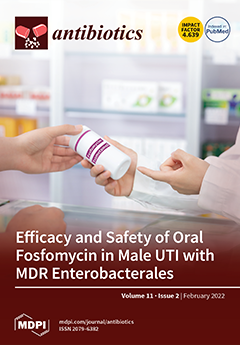In addition to the pathogenesis of SARS-CoV-2, bacterial co-infection plays an essential role in the incidence and progression of SARS-CoV-2 infections by increasing the severity of infection, as well as increasing disease symptoms, death rate and antimicrobial resistance (AMR). The current study was
[...] Read more.
In addition to the pathogenesis of SARS-CoV-2, bacterial co-infection plays an essential role in the incidence and progression of SARS-CoV-2 infections by increasing the severity of infection, as well as increasing disease symptoms, death rate and antimicrobial resistance (AMR). The current study was conducted in a tertiary-care hospital in Lahore, Pakistan, among hospitalized COVID-19 patients to see the prevalence of bacterial co-infections and the AMR rates among different isolated bacteria. Clinical samples for the laboratory diagnosis were collected from 1165 hospitalized COVID-19 patients, of which 423 were found to be positive for various bacterial infections. Most of the isolated bacteria were Gram-negative rods (
n = 366), followed by Gram-positive cocci (
n = 57). A significant association (
p < 0.05) was noted between the hospitalized COVID-19 patients and bacterial co-infections.
Staphylococcus aureus (
S. aureus) showed high resistance against tetracycline (61.7%),
Streptococcus pyogenes against penicillin (100%),
E. coli against Amp-clavulanic acid (88.72%),
Klebsiella pneumoniae against ampicillin (100%), and
Pseudomonas aeruginosa against ciprofloxacin (75.40%).
Acinetobacter baumannii was 100% resistant to the majority of tested antibiotics. The prevalence of methicillin-resistant
S. aureus (MRSA) was 14.7%. The topmost symptoms of >50% of COVID-19 patients were fever, fatigue, dyspnea and chest pain with a significant association (
p < 0.05) in bacterial co-infected patients. The current study results showed a comparatively high prevalence of AMR, which may become a severe health-related issue in the future. Therefore, strict compliance of antibiotic usage and employment of antibiotic stewardship programs at every public or private institutional level are recommended.
Full article






